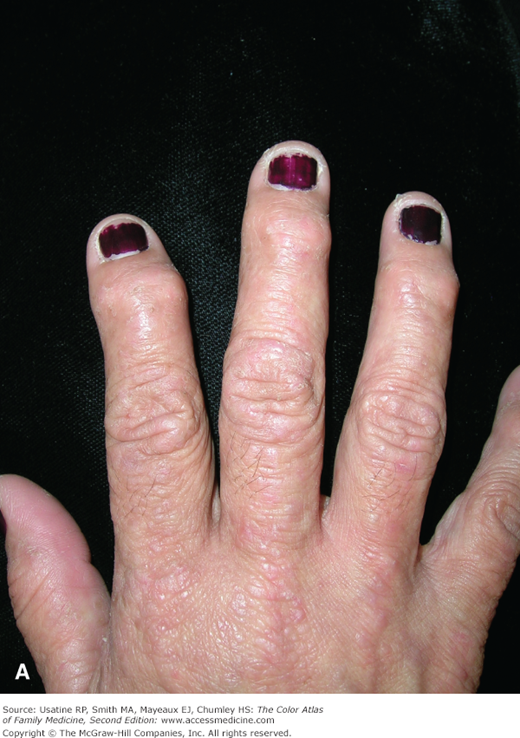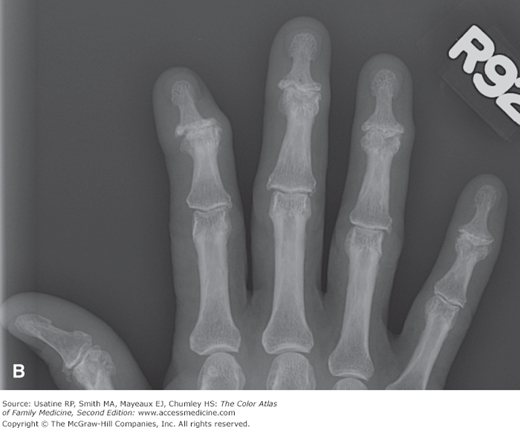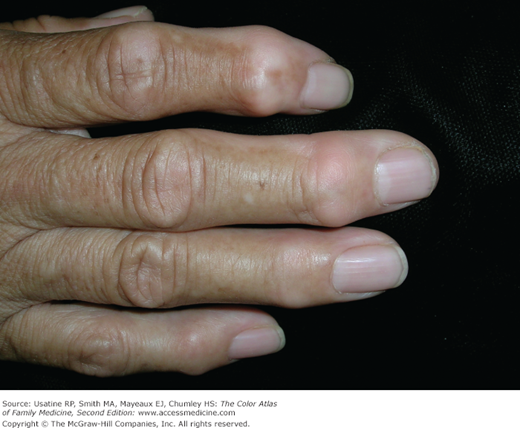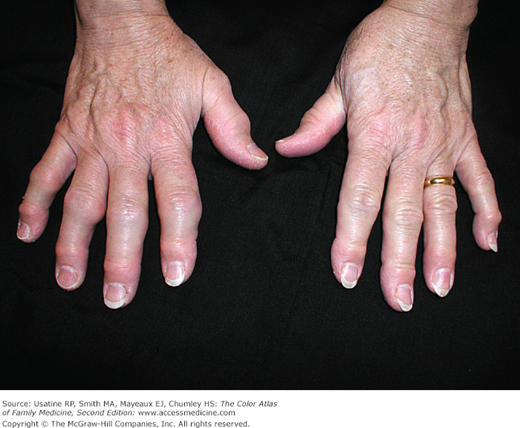Patient Story
A 50-year-old woman presents with new complaint of pain in several fingers. She has had psoriasis for many years; however, she only developed joint pain last year. Her examination is significant for swelling and tenderness at the distal interphalangeal (DIP) joints of her second, third, and fourth fingers (Figure 95-1, A). She had an elevated erythrocyte sedimentation rate (ESR) and radiographs with erosive changes (Figure 95-1, B). Choices for therapy include methotrexate and the new biologic anti-tumor necrosis factor (TNF)-α medications.
Figure 95-1
Psoriatic arthritis at initial presentation in a 50-year-old woman with psoriasis and new-onset hand pain. A. Note the prominent involvement of the distal interphalangeal joints. B. Radiography showing early psoriatic arthritis changes with periarticular erosions seen at the distal interphalangeal joints. (Courtesy of Richard P. Usatine, MD.)
Introduction
Arthritis means joint inflammation of the joints; however, the term is used for any disease or condition that affects joints or the tissues around the joints. Joint pain can be classified as monoarticular or polyarticular and inflammatory or noninflammatory. Diagnosis is based on a combination of clinical presentation, synovial fluid analysis, other laboratory tests, and radiographic findings. Management goals include minimizing joint damage, controlling pain, maximizing function, and improving quality of life.
Epidemiology
- Fifty million adults in the United States (22%) report doctor-diagnosed arthritis.1
- Arthritis is the most common cause of disability in the United States. Twenty-one million adults have functional limitations because of arthritis.1
- Fifty percent of adults age 65 years or older have been diagnosed with arthritis.1
- One in every 250 children younger than the age of 18 have some form of arthritis.2
- In 2003, the total cost attributable to arthritic conditions was $128 billion.3
Etiology and Pathophysiology
- Noninflammatory arthritis (i.e., osteoarthritis) is caused by bony overgrowth (osteophytes) and degeneration of cartilage and underlying bone (Figures 95-2 and 95-3).
- Autoimmune arthritis (i.e., rheumatoid arthritis, systemic lupus erythematosus [SLE], psoriatic arthritis) is caused by an inappropriate immune response.
- Crystalline arthritis (i.e., gout, calcium pyrophosphate dehydrate deposition disease) is caused by deposition of uric acid crystals (gout) or calcium pyrophosphate dehydrate crystals (CPPD) resulting in episodic flares with periods of remission.
- Septic arthritis is most commonly caused by bacteria (Neisseria gonorrhoeae, Staphylococcus, or Streptococcus; also gram-negative bacilli in immunocompromised patients and Salmonella in patients with sickle cell disease). Several viral illnesses may also have an associated arthritis.
- Postinfectious (reactive) arthritis is caused by an immune reaction several weeks after a urethritis or enteric infection.
- Fibromyalgia has an unknown etiology but includes abnormal pain perception processing.
Diagnosis
- Two features help limit the differential diagnosis: mono- or polyarticular and inflammatory or noninflammatory.
- Monoarticular noninflammatory—Osteoarthritis, trauma, atrioventricular node (AVN).
- Monoarticular inflammatory—Infectious (gonococcal, nongonococcal, Lyme disease) or crystalline (gout or CPPD).
- Polyarticular noninflammatory—Osteoarthritis.
- Polyarticular inflammatory—Rheumatologic (rheumatoid arthritis [RA], SLE, psoriatic, ankylosing spondylitis [AS], and others) or infectious (bacterial, viral, postinfectious) or crystalline later in the disease.
- Monoarticular noninflammatory—Osteoarthritis, trauma, atrioventricular node (AVN).
- Most commonly affected joints
- Osteoarthritis (see Chapter 96, Osteoarthritis)—Knees, hips, hands (DIP and proximal interphalangeal [PIP]), and spine (Figures 95-2, 95-3, and 95-4).
- RA (see Chapter 97, Rheumatoid Arthritis)—Wrists, metacarpophalangeal (MCP), PIP, metatarsophalangeal (MTP) early in the disease with larger joints affected later in the disease (Figures 95-5 and 95-6). Rheumatoid nodules may be found over the fingers, hands, wrists, or elbows (Figures 95-6 and 95-7).
- SLE—Hands, wrists, and knees (see Chapter 180, Lupus: Systemic and Cutaneous) (Figure 95-8).
- AS—Lower back and hips, costosternal junctions, shoulders (see Chapter 98, Ankylosing Spondylitis).
- Psoriatic arthritis—Hands, feet, knees, spine, sacroiliac; typically with a personal or family history or psoriasis (Figures 95-9, 95-10, and 95-11). The five types of psoriatic arthritis are: (1) Symmetric arthritis – Involves multiple symmetric pairs of joints in the hands and feet; resembles rheumatoid arthritis. Affects approximately 15% of patients with psoriatic arthritis.4 (2) Asymmetric arthritis – Involves only 1–3 joints in an asymmetric pattern and may affect any joint (e.g., knee, hip, ankle, and wrist). Hands and feet may have enlarged “sausage” digits due to dactylitis. Most common type found in approximately 80% of patients.4 (3) Distal interphalangeal predominant (DIP) – Involves distal joints of the fingers and toes. It may be confused with osteoarthritis, but nail changes are common in this type of PsA. The fingers with DIP involvement are most likely to have psoriatic nail changes such as pitting. This “classic type” occurs in approximately 5% of patients.4 (4) Spondylitis (Axial) – Inflammation of the spinal column causing a stiff neck and pain in the lower back and sacroiliac area. The arthritis may involve peripheral joints in the hands, arms, hips, legs, and feet.4 (5) Arthritis mutilans – A severe, deforming type of arthritis that usually affects a few joints in the hands and feet. It has been associated with pustular psoriasis. Affecting <5% of patients with PsA.4
- Gonococcal—Migratory with a single joint affected, such as knee, wrist, ankle, hand, or foot.
- Lyme disease—Knee and/or other large joints.
- Gout (see Chapter 100, Gout)—Begins as monoarticular with MTP joint of the first toe; hands, ankles, tarsal joints, and knee may also be affected (Figures 95-12, 95-13, and 95-14); gout may present with tophi over any joint; olecranon bursitis can also be the result of gout (Figure 95-15

Stay updated, free articles. Join our Telegram channel

Full access? Get Clinical Tree


- Osteoarthritis (see Chapter 96, Osteoarthritis)—Knees, hips, hands (DIP and proximal interphalangeal [PIP]), and spine (Figures 95-2, 95-3, and 95-4).




